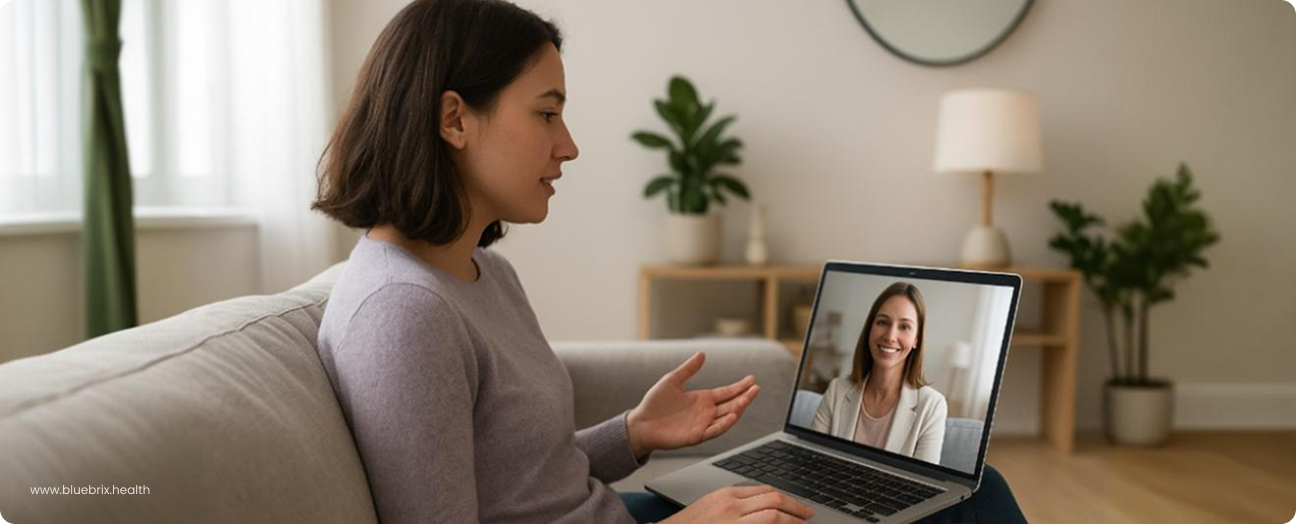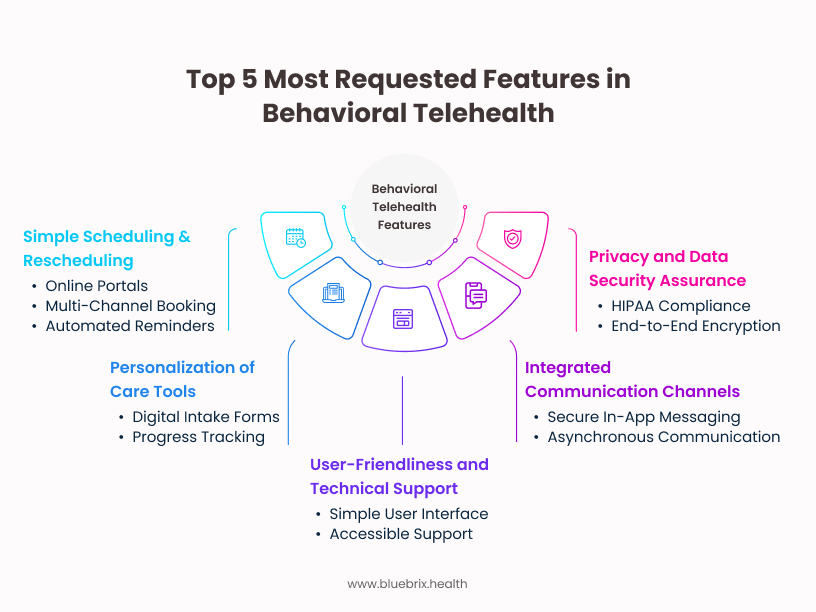
The way we live has changed dramatically, and mental healthcare is definitely part of that shift. Behavioral telehealth, which used to be a less common option, is now a fundamental part. As this area keeps changing, it’s really important to know what patients actually want from telehealth. This understanding is both helpful and absolutely crucial for giving truly effective and caring support. In this blog, we’ll break down the top five features patients consistently look for in a behavioral telehealth experience.
Why Patients Prefer Telehealth for Behavioral Health
Before diving into the “wants,” lets understand the fundamental “whys.” Why are patients choosing telehealth over traditional in-person visits? Patients increasingly choose telehealth for behavioral health due to a combination of practical, psychological, and accessibility-related benefits. The following are the key reasons why patients comparatively go for telehealth.
- Telehealth eliminates the need for commuting, helping patients save time and avoid the stress of traffic, parking, or taking time off work.
- Flexible scheduling options, including evenings or weekends, make it easier to attend sessions around work, school, or family responsibilities.
- Patients can access care from home, which provides emotional comfort, privacy, and supports consistency in recurring behavioral health appointments.
- It expands access for patients in rural or underserved areas by connecting them with specialists who may not be available locally.
- Telehealth ensures continuity of care, even when a patient or provider relocates or faces mobility or transportation challenges.
- Receiving care virtually helps patients feel more at ease discussing sensitive topics and reduces the stigma tied to visiting a mental health clinic.
- For those with anxiety, depression, or agoraphobia, telehealth eliminates the stress of leaving home and navigating public spaces.
The Top 5 Most Requested Features in Behavioral Health

While the foundational benefits draw patients in, it’s the specific features that keep them engaged and satisfied. Here are the five most requested functionalities that truly elevate the behavioral telehealth experience.
1. Simple Scheduling & Rescheduling
We are conditioned now to expect instant results, and healthcare scheduling is no exception. A simple scheduling process improves patient satisfaction and significantly reduces administrative burden for mental health practices, allowing providers to focus more on patient care. What makes this possible?
- Online Portals with Real-Time Availability: Patients want to see their therapist’s or psychiatrist’s open slots immediately, allowing them to book at their convenience, 24/7.
- Multi-Channel Booking: Give patients the flexibility to book through multiple channels they’re most comfortable with such as phone, chat, WhatsApp, email, or your website.
- Individual and Group Therapy Session Management: Whether it’s a one-on-one session or a group therapy appointment, it should be just as easy to schedule and manage.
- Integration with Provider Calendars: A patient-facing scheduler directly syncing with the provider’s professional calendar (e.g., Google Calendar, Outlook), that can eliminate double-booking and manual updates.
- Easy Cancellation and Rescheduling Options: Life happens. Patients need the flexibility to adjust their appointments without hassle, ideally with just a few clicks within the platform.
- Automated Reminders (SMS, Email): Life is busy. Gentle nudges via text or email prevent missed appointments, reducing no-shows and ensuring continuity of care.
2. Privacy and Data Security Assurance
Mental health data is among the most sensitive personal information. Patients need absolute confidence that their private conversations and personal health information (PHI) are safe. This is more than compliance, its’ about building a trust that encourages open and deeper communication. The following features help here.
- HIPAA Compliance: This is non-negotiable. Patients expect platforms to adhere strictly to these regulations, ensuring data protection and privacy.
- End-to-End Encryption for Video Calls and Data Transmission: This technical safeguard ensures that only the sender and intended recipient can read messages or hear conversations. This can prevent eavesdropping or data interception.
- Secure Document Sharing and Storage: From intake forms to therapy worksheets and progress notes, all digital documents must be stored and shared through secure, encrypted channels.
3. Integrated Communication Channels Beyond Video Calls
While video is central, effective care requires personalized communication that is even supported outside of scheduled sessions. This develops a more holistic care experience, breaking down the artificial barriers of “session time” eventually promoting better patient engagement. Patients appreciate a unified platform that facilitates this.
- Secure In-App Messaging with Providers: For quick questions, check-ins, or follow-ups, a secure messaging feature within the platform.
- Options for Asynchronous Communication: Sometimes, a patient might need to share a thought or feeling outside of session hours. Features like secure audio messages or text updates to allow for this flexibility without requiring a live interaction.
- Notifications for New Messages or Updates: Just like any other communication app, patients expect timely notifications when their provider sends a message or when new resources are available.
- Support for Group Therapy Communication: For group sessions, multi-user coordination and shared updates ensure all participants stay informed, enhancing collective engagement and reducing friction.
4. Personalization of Care Tools
Mental health journeys should feel personal. Patients seek platforms that recognize and support their unique needs and care requirements. Features listed below could transform the telehealth platform from just a video conferencing tool into a complete care management system, to make patients more engaged and improve adherence.
- Digital Intake Forms and Assessments (Pre-Session): Making the initial paperwork easier allows patients to complete it comfortably at home.
- Progress Tracking and Goal Setting Features: Seeing tangible progress can be incredibly motivating. Features that allow patients and providers to track goals, symptoms, or mood over time to provide insights and reinforce the therapy process is a top choice.
- Resource Library within the Platform: Curated articles, exercises, mindfulness guides, or relevant external links, easily accessible within the platform, that can provide valuable self-help tools.
- Option for “My Care Team” View: For patients receiving multidisciplinary care (e.g., therapist, psychiatrist, nutritionist), an integrated view of their care team, and potentially shared insights (with consent), can provide a cohesive experience.
5. User-Friendliness and Technical Support
Even with the best features, an unreliable platform can quickly collapse the therapy process. Ease of use and dependable technical support are foundational for patient satisfaction.
- Simple, Clean User Interface (for both web and mobile): The platform should be intuitive, requiring minimal technical expertise. A cluttered or confusing interface creates frustration and anxiety.
- Minimal Technical Glitches (video and audio Quality): Dropped calls, pixelated video, or echoing audio are major deterrents. Patients expect reliable, high-definition connections that mimic the clarity of in-person interaction.
- Accessible Customer/Technical Support (chat, phone, email): When issues arise, patients need quick and easy access to help. A responsive support team can turn a frustrating experience into a positive one.
- Multi-Device Compatibility: Patients should be able to seamlessly switch between their desktop, tablet, or smartphone without losing functionality or compromising their experience.
How blueBriX Address These Needs
Patients expect full control over their care journey—and our behavioral telehealth platform delivers with 24/7 real-time scheduling, seamless calendar sync (Google, Outlook, iCal), and automated reminders that reduce no-shows. Built for privacy with HIPAA, 42 CFR Part 2, and HITRUST compliance, blueBriX uses end-to-end encryption to secure everything from live video to stored files. Engagement goes beyond sessions with secure in-app messaging, real-time alerts, and encrypted file sharing. With 200+ prebuilt clinical assessments, digital intake tools, outcome tracking, and progress dashboards, care is personalized at every step. Our platform empowers patients while enabling providers to deliver efficient, compliant, and connected care.
Conclusion: The Importance of Patient-Centric Design in Telehealth
As Dr. Vivek Murthy, U.S. Surgeon General, wisely stated,
“The world is suffering from an epidemic of loneliness and isolation. If we fail to address this, we will pay an ever-increasing price in the form of our individual and collective health and well-being.”
Behavioral telehealth isn’t just about convenience—it’s about connection, continuity, and care. Building tools that make patients feel secure, heard, and supported is essential. By putting patient preferences at the forefront, you can collectively build a more accessible, effective, and compassionate mental healthcare ecosystem for everyone.
At blueBriX, our mission is to continuously innovate and provide the tools that empower your patients. Dream up the features that you want, and we’ll work to bring them to life. Contact us today to learn how blueBriX can help.